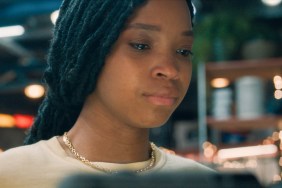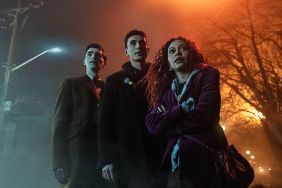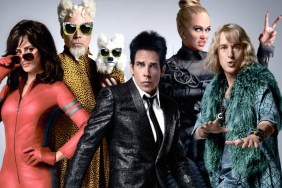Trading in the chainsaw for a machete

This is the man who likes to reboot nightmares. His visage and attire are befitting of a man you might find traversing the jungles of the Amazon looking for adventure: prominent beard, handkerchief covering his head, shirt unbuttoned to reveal multiple necklaces. Marcus Nispel ducks into our press room at the Four Seasons in Beverly Hills on this Saturday afternoon extending handshakes and introductions. Five minutes prior to our interview, I overhear him talking in the hallway with actor Jared Padalecki about a new gardening technique, backing up rumors that he’s a man who likes his “organics.” A real gardening nut. A real salt of the Earth type. But this one has a history in music videos and is, of course, known for remaking Tobe Hooper’s classic The Texas Chainsaw Massacre. This week, audiences will see his take on Friday the 13th.
“Am I with friendlies?” Nispel sheepishly asks the surrounding journalists. He recounts for us an experience on the press tour for The Texas Chainsaw Massacre where he was thrown to the wolves which made for an uncomfortable Q&A. “It was apparent everyone in the room hated the movie.” We alleviate his worries with a positive endorsement for his latest effort, then grill him on what put him back at the helm of another franchise reboot.
“You always go to your agent and say no more of these! You feel you have to say it,” he laughs. In spite of this order to his representation, he had a desire to revisit the life and times of Jason Voorhees. When he put in a call to Platinum Dunes’ Michael Bay, Brad Fuller and Andrew Form, it turns out the trio were in the process of shoring up the rights.

At the time there was talk another member of the chainsaw family, Jonathan Liebesman (The Texas Chainsaw Massacre: The Beginning), was going to direct. But a few script drafts later, Platinum turned to Nispel and writers Mark Swift and Damian Shannon (interview). “I had no idea they had gotten the rights. They told me they didn’t like the [other] scripts. They had three weeks with two writers to come up with something and [all of us to please] – New Line, Paramount, Warner Bros. then Michael Bay and me. It had to be right.”
“The mandate was we didn’t want to make torture porn and that’s never what Friday the 13th was,” he continues. “The Texas Chainsaw Massacre was dread, and Friday the 13th always had levity in it, but it was levity that came out of the kids.”
To bring this somewhat lighter, naturalistic – but indisputably violent – tone to the picture, Nispel surrounded himself with a cast that included Derek Mears as Jason, Amanda Righetti, Danielle Panabaker, Travis Van Winkle, Aaron Yoo and Arlen Escarpeta. The latter two providing many of the film’s laughs. The director admits he was taken aback by the casting of Supernatural‘s Jared Padalecki. “He’s considered a superstar, which means you don’t get to meet them really before you make the deal. When he walked through the door I thought, he’s bigger than Jason! We had to deal with that. Then when Danielle [Panabaker] came through the door, I was like, okay we need apple boxes. One has to be bigger, one has to be smaller.”
Apple box juggling was a far cry from what Aaron Yu faced. Nispel tells us the actor had his appendix removed prior to shooting. Adjustments were made to the schedule to work around him, but shortly after surgery, the director had Yu suspended from the rafters upside down. “His shirt would fall down and there would still be the staples!” Nispel smiles.

The story and location dictated his approach to the visual language of Friday the 13th and the notion of making it look similar or different to Chainsaw wasn’t at the forefront of his mind. “I really believe a movie tells you what’s going on. The underground, the forest…and out of that the style evolves. As stylized as my films come across, I don’t like to go into it and get overly fancy. Being blessed with a great cast of kids, my job is really sometimes to just blend into the wallpaper, like reality TV – let the camera rattle and make sense of it later in editing, so it’s authentic but not contrived.”
Waxing philosophical about the purity of a Friday the 13th film is a new one on us, but Nispel does it well. He continues on about how it was always difficult to capture the real spirit of Tobe Hooper’s 1974 effort. “When I signed up to do Chainsaw, I didn’t know what a holy cow it was in the eyes of the ’70s filmmakers. You can never rekindle that shock value, so to hear how many people did not want us to make that movie, it was daunting. I had no idea what I signed onto. On Friday the 13th, it was the other way around.” And that’s because audiences were more accepting to see new chapters in the franchise. “What makes 12 directors want to make, ostensibly, the same movies? What makes masses of fans want to see the same movie over and over again? There are better movies, more expensive movies people only want to see once – they’ll make a sequel, but nobody comes. So what is it about these movies that makes people want to see them over and over again?”

The formula, the familiarity and, of course, Jason Voorhees, we answer. Nispel agrees it most definitely has to do with the last part of that equation. “When I worked with the writer I noticed a very interesting thing,” he says. “They never referred to [Jason] as the monster, they called him our anti-hero. The villain was really the jerk kid, which tells you a lot about the writers, they’re the guys who were not so popular on prom night. We were the guys who saw a certain amount of scorn!” As for the “formula”: “You want to build [the scares and kills] differently because you want to screw with the audience’s perception of what will happen next. Especially with Friday the 13th, it’s who is going to get it next? You never want to see it coming and sometimes a,” Nispel does his take the famous Harry Manfredini “ki-ki-ki ma-ma-ma” score, “is advertising a scare so my mantra was only use it for fake scares. Make people be on the edge but the real scares, never give them away.”
When pressed for details on a possible director’s cut for the DVD release, he replies: “They asked Cameron once if he regretted the hour he had to lose from Titanic‘s original cut and he said, What sculptor regrets the sculpture for the chips that had to fall off in order to retain it? So I had to look at it the same way.” What chips fell away? “I did have scenes about [Jason’s] mask flying off that I felt very strong about. Is it scarier by having the hero exposing his humanity or by hiding it?”




Source: Ryan Rotten, Managing Editor









